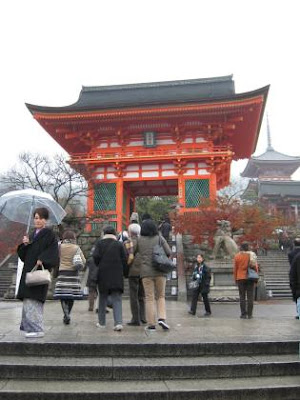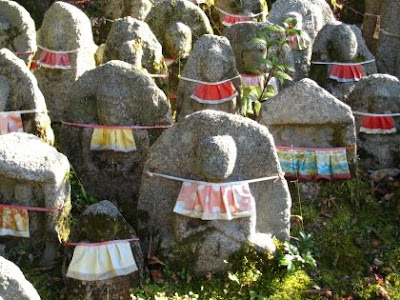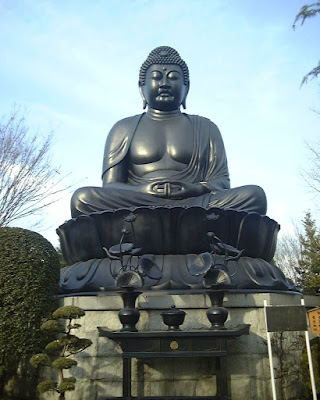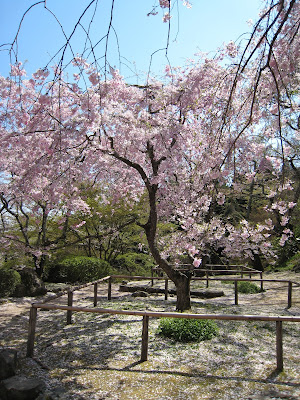With
Modern Japanese Cuisine: Food, Power and National Identity Katarzyna J. Cwiertka has written the best book about Japanese food culture I know. It is much more than the title says: this essay is not only about modern cuisine, that is to say how the Japanese came to eat meat and other outlandish dishes, but much more importantly, it reveals how Japanese food as such was defined. Like many other “typically Japanese” cultural experiences,
washoku, the “traditional” Japanese cuisine was only devised in the late 19
th - 20
th century, after Japan opened its gates to the world.
Take rice, which is still considered as an almost sacred, Ur-Japanese basic food: in pre-modern times rice was only eaten by a few percent of the population, the upperclasses, the rest – including those who cultivated it – could not afford it. Farmers paid their taxes in rice and only in very good years could they eat some of it, mixed with other grains and vegetables – and that was not the present-day white rice. White rice was introduced with a vengeance by the military in the Meiji-period: the boys who joined the ranks, had the privilege to eat nothing but white rice for the first time, and many of them lost their lives before they reached the battlefield, as a diet of only white rice causes beri-beri due to Vitamin B1 deficit, but that was not known yet in the early 20
th c.
Meat for a vegetarian nationWestern food was introduced at state banquets during the early Meiji years, the period of "Civilization and Enlightenment," which included the lifting of the ban on meat which had been first issued in 675. Although the Japanese did eat seafood and some game, since the 16
th c. the eating of meat of domesticated animals as cows was in fact taboo. That was not so much religious (Buddhist) but rather practical: draft animals were needed for food production, there was no space among the rice paddies that constituted the Japanese countryside (and were necessary for tax payments as we have seen) for even small-scale cattle husbandry. Meat was eaten seldom and then only for medicinal reasons.
Many Japanese thought those partaking of meat had a bad smell and that was undoubtedly the case with the British (who in the 19
th c. ate nothing but meat, they conveniently believed vegetables were unhealthy) and other Westerners, who only on rare occasions took a bath in contrast to the clean Japanese. So it needed the authority of no one else than the Emperor to break the cultural ban: in 1872 it was officially declared that the Emperor was partaking of meat on a regular basis.
Treaty port recipes
It was still a long way to a sufficient supply of good meat and to multicultural gastronomy but here the Treaty Ports played an important part. The Westerners living in Japan of course kept their own cuisine as much as possible (they considered the “native food” as “inferior”) and taught their Japanese servants how to cook these. These cooks later set up their own restaurants, usually exclusive ones. Hotels catering to foreigners also started restaurants offering
yoshoku, Western dishes, first cooked by foreign cooks, later by their Japanese apprentices. All this was rather expensive, but from the mid-twenties on large department stores as Mitsukoshi and Matsuya started setting up affordable Western-style restaurants, finally making multicultural menus available to the urban masses.
Yoshoku was predominantly Anglo-Saxon, so we find beef, croquettes, rolled cabbage, omelet and of course curry rice – introduced by British expats who had served in India, but quickly made their own by the Japanese.
Military menus
The largest role not only in normalizing such multicultural dishes but also in defining the national cuisine was played by the military. After all, all Japanese males, half the population, had to serve as conscripts and eat what they were served. This experience shaped their future food preferences. The military introduced white rice as the centerpiece of the meal, as we saw, and added soy sauce as a crucial flavoring agent. They would also include miso soup. What set the military apart from the rest of the population was the inclusion of “multicultural” side dishes: popular were curries, croquettes and Chinese stir-fries. The reasons were practical: the men came from all over Japan and had different tastes where Japanese food was concerned but all liked the new, multicultural dishes. Moreover, these were easy to handle with a modern, military catering system.
Home cooking
In these years also the home meal was reformed. Women became devoted
shufu, housewives of nuclear families, and they governed their
katei, their home, as they were supposed to do for most of the 20
th century. Not only were cooking schools established where housewives could learn modern home cooking, a host of women’s magazines also helped them on the way with recipes – there were even very popular recipe contests. But also home cooking was multicultural, it was
wayo setchu ryori, “Japanese-Western fusion cuisine,” and thanks to the fact that they were eaten in the home many hybrid recipes of the early 20
th c. are now nostalgically seen as the ultimate Japanese “mother’s cooking.” Also in the home, meals were structured on the traditional rice-soup-side dishes pattern, only the number of side dishes was enlarged and more variety was sought in their recipes.
Military nutrition again
The war and its aftermath of course changed everything again, with severe food shortages and rationing. It made not only the
hinomaru bento popular, white rice with a red pickled plum in the middle, but also led to the acceptance of other staples than rice, notably bread and noodles. It also erased the difference in cuisine that still existed between city and countryside. Substitute foods were discovered, as the potato sandwich. The militarization of nutrition was continued after the war in civilian canteens (companies, universities) with their curries and other easy dishes and gradually became mainstream civilian culture.
Imperialist cuisine
Japanese imperialism during the first half of the 20th c. had another effect on food culture: the embracing of Chinese food as the third pillar of Japanese cuisine, together with Western and Japanese dishes. Ramen noodles already became popular in the thirties, although they differed from Japanese cuisine with their stock of chicken or pork broth instead of soups based on kelp or
katsuo (bonito). It was the imperialist expansion into China that helped popularize Chinese food in Japan. And after the war this was reinforced by the fact that many now unemployed soldiers knew how to cook Chinese. They started making
gyoza dumplings, a product of wheat flower which in contrast to rice was still available - moreover, dumplings can be filled with about anything, which also came in handy in that period of shortages.
Korean food, by the way, was a different matter.
Kimch’i was only accepted in the nineties, during a Korea Boom due to the Seoul Olympics and later a popular television series. But already in the years of food shortage after the war,
yakiniku, grilled meat, became popular (first as
horumon-yaki, using tripe and offal). Koreans in fact played a large role in the popularization of meat in Japan – another fact is that in the early 20
th c. most meat eaten in Japan was imported from Korea, another culinary consequence of imperialism.
Postwar Affluence
Affluence in the second half of the 20
th century brought huge dietary changes of its own. Now Japan became the willing victim of American "cultural imperialism," a fascination which led to hamburgers, pizza and French fries, rice cookers and refrigerators, frozen foods and instant foods, McDonalds (so common in Japan that Japanese kids think it is native – it was introduced in 1971 by Fujita Den) and Starbucks. Bread was further popularized at school lunches, and milk and dairy products also became popular. Dining out became pastime number one and family restaurants as Denny's proliferated. Home cooking suffered, but was made infinitely easier by all pre-cooked products now becoming available. In the same period, Japan's cuisine, in the form of sushi and teppanyaki, gradually started going global.
The Construction of a National Cuisine
What Cwiertka so aptly shows us, is that Japanese cuisine “is a modern construct conceived in the midst of the 20
th century's historical dynamics.”
Washoku, while presented as something timeless and unchanging, is a modern invention - although resting upon traditional foundations. One such foundation is of course
kaiseki, the meal taken during the tea ceremony that was reconstituted in the 20
th c. by chefs as Yuki Teiichi into an extravagant “authentic Japanese” dining experience. The arrangement of foods on dishes in
kaiseki even influenced Japanese home cooking in the first half of the 20
th c.
What it all serves to demonstrate is that Japanese food culture is not exotic, unique or even traditional – Japanese national cuisine was devised and defined in the 20
th century and
Modern Japanese Cuisine unveils the story behind that process.










































